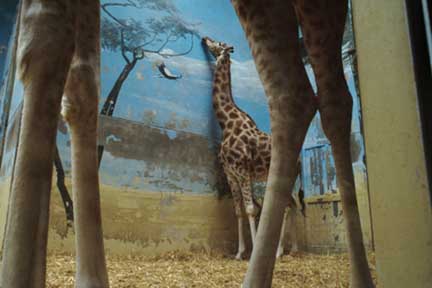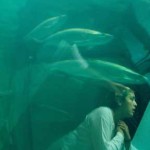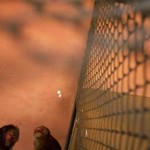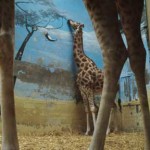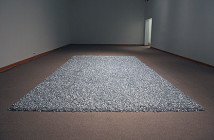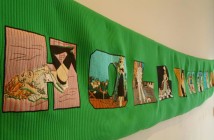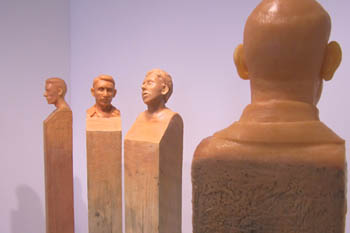Animal art. That's a pairing of words whose particular combination can send many in the art world running for the door. But that's because we normally associate it with the world of cutesy kitsch. There are in fact a good many contemporary artists who have taken on this hairy subject and opened it up to new insights, Rebecca Norris Webb is one such talent.
What interested me initially while sifting through the press releases was that rather than photographs of animals either wild or domesticated, Webb had chosen to focus her camera on the world's zoos, aquariums, and natural history museums- a kind of purgatory between the wild and the tame.
Webb, who in her college days had been a poet, found after leaving school that poetry had just left her. Her solution was to travel the world with a camera that she hoped would capture source material to inspire new poems. What she developed in her travels was a fascination with the world's zoos. As she began to document her visits, she soon found that this process was becoming an art in itself a kind of visual poetry.
She has been documenting the lives of animals at zoos and their bodies at natural history museums ever since and this recent show brings together some of her recent work.
The one that really got me was "Paris, 2002 (giraffes)", the one she smartly selected for her postcard image. Shot from between a giraffes legs, we see two others milling about in the small space of a cramped cell. One is occupying itself by sadly attempting to lick the leaves off a painted tree, part of a poorly painted mural that serves as the cage's backdrop. Webb caught the giraffe in the moment just as it experiences the disappointing taste of dirty concrete. I wondered if it was captivity that had robbed the unsuspecting creature of the ability to distinguish between real and painted trees. It was a tender moment, a gesture tinged with longing and a palpable sadness. Perhaps a zoologist would be better able to explain this giraffe's sad mishap in ways not so metaphoric, but that would not degrade the empathy I have for the subject. And its empathy that makes this picture so arresting.
On the opposite wall was "Havana 2003 (monkeys)". From the right corner of the frame two macaques stare out pensively at their viewers, (or perhaps Webb's camera.) Their body language caught in an awkward slightly embarrassed phrase. It felt as if they didn't like being looked at, and that drew me closer. Behind them a wall painted a deep orange blazed out, here and there punctuated with signs of disrepair. With monkeys its not hard to feel a human connection and this is dramatized by the way in which these two seem almost like a couple, a pair, so tired of being viewed. Their unsettling self-conscious stare seemed to point an almost accusing finger at their spectators a group which now included me, part of the extended audience who now sees them as art.
On the wall going up the staircase, were Webb's photos of natural history museum specimens. One of the last in this grouping was of a stuffed lion behind bars. It was such a spectacular visual pun. Here a dead thing was made to look more real by placing it behind bars. Bars are fierce tools usually meant to forcibly contain something wild or believed wild, and this is probably why the museum presented it this way. We paradoxically associate the wild with the need to be contained and its containment accentuates our sense of being close to the untamed. The real kicker was that to the left of
the cage were two barred windows suggesting equal imprisonment for both specimen and spectator. The trophy's eyes were frozen in a dead stare. A felt silence pervaded the scene, a point furthered by the sunset ablaze outside the windows and over the city. The museum's interior was dark by contrast. I wondered if it was closing time. These elements together reverberated a nostalgic residue, something a bit eerie even lonely. I wanted something to be happening; a person to be in the space, for the lion to leap, to sense life out in the city, but everything in the picture was trapped in a stifling, placid, thick atmosphere.
Not all of Webb's work is by any means so moody. Some of her more whimsical photographs have come from her many visits to aquariums. In "Veracruz, Mexico 2003 (fish)", a young woman dreamily looks out into a school of fish, her image warped by the refraction of light as it passed through the glass tank before coming to rest on Webb's lens. I liked the way this image evoked the relationship between viewer and animal and how both were woven together to form a distorted composite.
In her artist statement Webb quotes Polish poet Milosz who once wrote "we are always separated from nature as if by a glass wall." So the "glass between" in Webb's work is a loaded term and it carries a many-layered definition. It refers of course literally to the glass that keeps the animals in their cages and to Webb's interest in the optics of reflection and refraction. But the distortion that Webb addresses is more than just the physical distortion created by shooting through glass. The distortions also suggest the way looking at anything changes to some extent its meaning. When you marry this to the subject of animals in zoos then the clarity of meaning becomes really harrowing. What is before our eyes in Webb's work? Are these animals, trophies, or specimens? Are zoos places that preserve nature or do they just put it on show like a kind of macabre theatre?
For Webb, her subjects are never animals alone. They are really more reflections on the cultures of display as defined by our world's zoos, aquariums and natural history museums. She captures for us the captured and reframes their display status by shifting their roles from that of exhibits to subjects.
Standing in the griffin that day I could not but help consider all of this from the standpoint of an art gallery and the situation of viewing art. Galleries and museums much like zoos are in the business of displaying the exotic within very controlled environments. I wondered what the framing edge meant for these animals. Was this but another cage, the gallery another zoo?
Zoos can be accused of exploitation, but what I discovered through Webb's work was that the line between exhibition and exploitation is a tight rope walked by any institution that devotes itself to the art of display.
Apart from all of this though, the work is simply quite beautiful. Webb with intelligence and photographic confidence brings a weight and a gravitas to the lives of these animals. Animal art is hard to do well, and in Webb's work one can almost forget that these are pictures of animals because the dramas they enact feel so very human.
- Rebeccca Norris Webb, Veracruz, Mexico, (fish), 2003
- Rebeccca Norris Webb, Havanna, (monkeys), 2003
- Rebeccca Norris Webb, Paris (giraffes), 2002
----
Links:
Griffin Museum of Photography
"The Glass Between Us" is on view The Griffin Museum of Photography inWinchester, MA until July 10.
All images are courtesy of the artist and The Griffin Museum of Photography.

